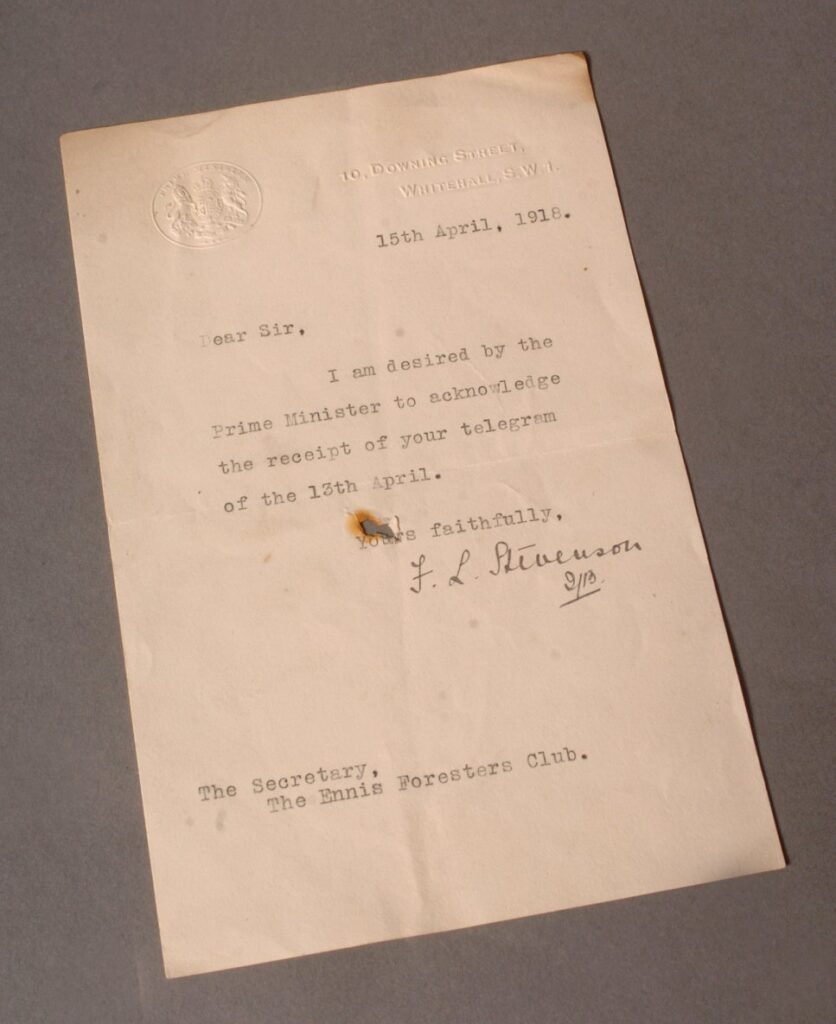Cataloguing the collection allows a staff member to take a closer look at an artefact from the past. Often, we find some unexpected detail that adds another layer or dimension to the story it tells us. A typical example of this occurred when a short letter from 1918 was being examined a few years ago.
The Letter
The typed letter was on headed paper from a familiar address – 10 Downing Street, London. It came to the museum in 2004, along with a banner and some other documents, from a building in O’Connell Street, Ennis. The building had been the HQ of the Ennis club of Irish National Foresters.
The INF began in 1877, when it broke away from the British-based Ancient Order of Foresters. The AOF did not agree with the support their Irish members had for Irish nationalists causes. After the split, the constitution of the INF called for “government for Ireland by the Irish people in accordance with Irish ideas and Irish aspirations”.
The letter from Downing Street reads:
10 Downing Street,
Whitehall, SW 1
15th April 1918
Dear Sir,
I am desired by the Prime Minister to acknowledge the receipt
of your telegram of the 13 April.
Yours faithfully,
F L Stevenson
CBE
The Crisis
The date on the letter, April 1918, was during the time of the Irish Conscription Crisis.
During the second year of the war, in 1915, the British Army had suffered terrible casualties. It needed more fighting men, and so the British government brought in conscription to Britain in January 1916. Ireland was not included in this decision.
In the spring of 1918, a German attack on the western front brought conscription up again. This time it was Irishmen who would face compulsory enlistment. Conscription was unpopular across Irish society. For example, the Catholic Church, Irish Party and Sinn Féin, were all against it. It was natural for the Ennis Foresters to oppose it.
Some letters from the MP for West Clare, Arthur Lynch are also in the Ennis Foresters collection. They tell us how opposition to conscription organised themselves and that the Ennis Foresters had a role to play. It is likely that the letter from London is to acknowledge a telegram of protest sent by the Ennis Foresters to Downing Street.
The New Information
The new information came when attention turned to the signature on the letter. Who was F L Stevenson? A quick search online provided the answer.
F L Stevenson was the personal secretary of David Lloyd George. She first met Lloyd George through his daughter with whom she was friendly in school. In 1911 he hired Stevenson to be a governess to his youngest daughter, Megan. Even though she was 25 years younger than him, a relationship between the two began in about 1913. It was then that she agreed to become his personal secretary and mistress.
In the 1918 New Year’s Honours List, Stevenson became a Commander of the Order of the British Empire. Indeed, the letters CBE may be what she wrote under her signature on the letter to the Ennis Foresters.
The relationship between Lloyd George and Stevenson was an open secret in Westminster. But, when they were both at the Paris Peace Conference in January 1919, none of the delegates were aware of the secret relationship. It seems unlikely that the members of the Ennis Foresters Club had any idea about it either.
David Lloyd George married Florence Stevenson in 1943. It was two years after his first wife died and the marriage did not have the approval of his children. The marriage was brief, as David Lloyd George died on 26 March 1945. Stevenson lived on until 1972.
When cataloguing an artefact, it pays to check the small details. It is these details that can provide unexpected nuggets of information. This information can provide a fuller picture or tell a deeper story than the one you may have expected.
Why not take a look at other artefacts in the Ennis Foresters collection at Clare Museum?

